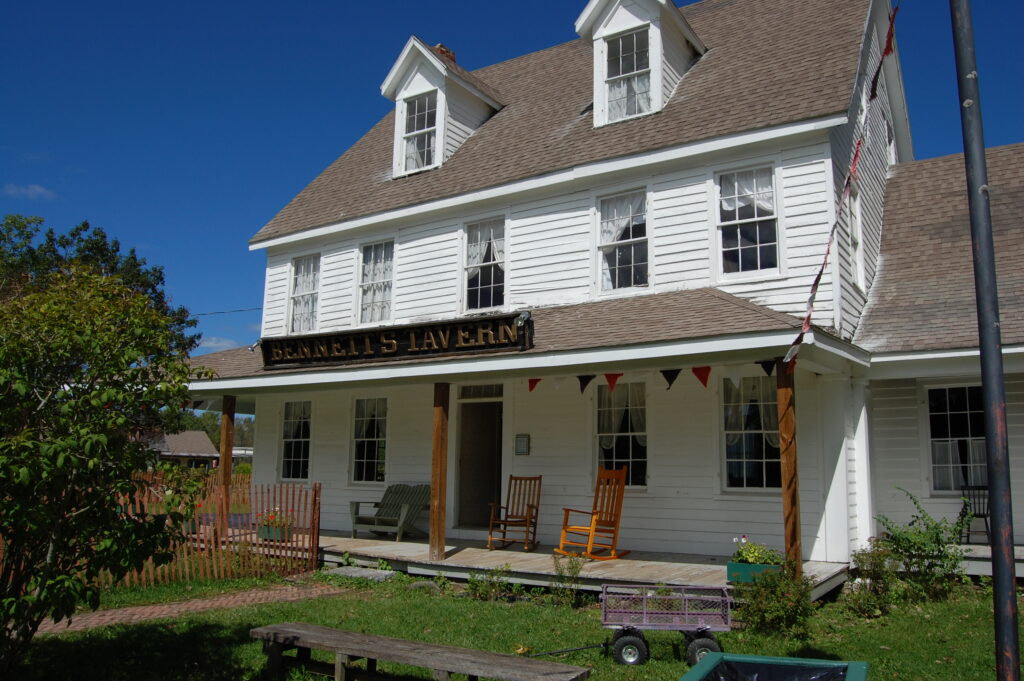Bennett's Tavern
Built: 1911
Moved to Village: 1974
Original Location: McConnellsville, NY
 When the Watertown and Rome Railroad was well advanced and completion seemed assured, Alanson Bennett, a prominent Roman, had a tavern built on its route through McConnellsville. From the 18501s through the 18701 s the tavern must have played an important role in the comings and goings of those in McConnellsville and surrounding loc aliti es. But much must be left to speculation as no record was found of the tavern’s activities during these years.
When the Watertown and Rome Railroad was well advanced and completion seemed assured, Alanson Bennett, a prominent Roman, had a tavern built on its route through McConnellsville. From the 18501s through the 18701 s the tavern must have played an important role in the comings and goings of those in McConnellsville and surrounding loc aliti es. But much must be left to speculation as no record was found of the tavern’s activities during these years.
Bennett’s Tavern crops up on early maps and deeds. Some older residents of McConnellsville recall hearing stories of stage coaches driving up to the hotel, and a torn slip of paper was found from a butcher to a Mr. Fox at the tavern. The building was sold to George Gibbons in 1883 and it was used as the Gibbons home from that time.
The tavern must have been a natural meeting place for travelers coming and going by stagecoach and rail. Several trains stopped in McConnellsville on their way to Cape Vincent and the North Country. Rails were eventually opened to the Thousand Islands. Bennett’s was one of three inns in McConnellsville.
The tavern must have been very busy for the. floors are well worn. The kitchen floor is new, but it’s the third one it’s bad. The side door to the barroom is on its fifth latch.
The tavern was the place to learn news of all kinds. Here were the bagmen or drummers– traveling salesmen of the time with their wares in a suitcase laid out in the “sample room” upstairs. Out front, a long porch, parallel to the tracks 20 feet away, provided front row seats to one of the Village’s greatest spectacles–the arrival of the train.
The tavern was laid out with three public rooms on the first floor: barroom, dining room and parlor. Men met in the bar while their horses were tied outside or stabled i f the stay would be overnight. “Fine accommodations for man and beast” read ma n;’/ a tavern sign. In the bar the men chewed, smoked or sniffed tobacco, drank rum, gin, brandy, D12diera, local whiskey or hard cider.
Bennett’s Tavern served meals at Rppointed hours in the ordinary or dining room. In this long room tables and benches probably accommodated more people than was comfortable on occasion and the meals served were probably from a set menu at a fixed price. Meals were heavy and served punctually.
There were a variety of :things to be consumed at breakfast as well as dinner. The food would usually be quite good, if not haute cuisine; and if accounts of European travelers applied here, it was eaten quickly and noisily. The parlor, in contrast to the bar and dining room, was a quiet place, often deserted, filled ‘With comfortable furniture and reading material. It was used by the women and by those persons staying at the tavern. The stove was located by the burned spots on the floor boards. The piano was a frequent feature of a tavern’s parlor; the room also held a pier mirror which rose to near ceiling height behind where the late American Empire period sofa rests.
The largest room on the first floor is the kitchen. The innkeeper’s wife may have cooked the meals, or she may have found help in a single woman who lived in the little room to the right of the fireplace. Additional help may nave slept upstairs. Bennett’s, built ca. 1850, probably had an iron cookstove which was used in deference to the traditional fireplace. But the brick bake oven and additional cooking capacity afforded by the fireplace crane were undoubtedly used. This kitchen probably had the stove located a little in front of the fireplace. The kitchen table, a sturdy plain affair, was located in the middle of the floor. The kitchen sink is one of two original pieces in the hotel; judging by a pipe hole in the floor, it was always where it is now. The splash board and cast iron sink, however, are not original.
Pantries were for keeping food. All but root vegetables and fruit was kept here. Packaging, such as tin cans, cartons and other disposable riontainers was not practiced to any extent in the 18501s. Foodstuffs were bought from large containers at n store, sacked or wrepped, and brought to the pantry where they were placed in smaller containers and bins.

